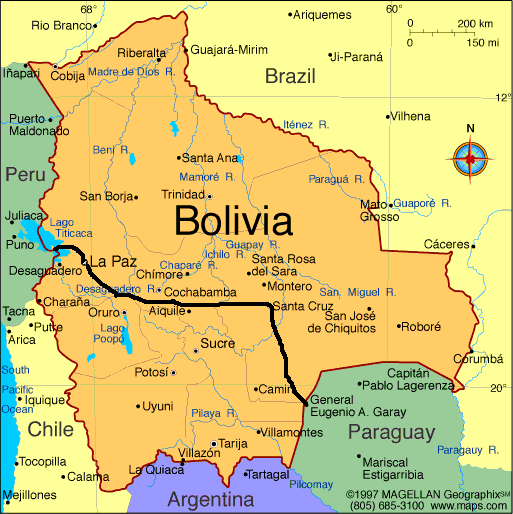Well I can confirm that there are mountains in Bolivia. Lots of them. Big ones. And the roads among the mountains are not all paved which makes it impossible for me to cycle uphill for very long. But first things first. Here is my intended route in Bolivia.
I spent a couple days in Santa Cruz preparing for my trek into the mountains. My plan was to cycle from Santa Cruz to Cochabamba, a distance of about 500 km or about 310 miles. I knew it was hilly but my map said the road was paved. Now, I don´t trust maps. I usually try to get two or three just to compare them. In this case I bought three maps and they all showed that the road was paved. Maybe it was paved years ago, but not anymore, as I found out half way through.
But before leaving Santa Cruz I wandered through the market area and took these pix. It was a fascinating place, full of energy and excitement.
Once leaving Santa Cruz the road started going up and was paved for the first few days. I stopped in the town of Samaipata where I toured some old pre-Inca ruins and took a day to hike through the forest observing giant ferns. Here is a shot on the way to Samaipata and a look at the the town.
Camping was difficult because, well, mountains have steep sides to them and it is not always easy to find a flat spot out of the way. Once I even had to sleep in a guy´s garage because there was no other accommodation around.
This was in the small village of Mataral, where I took a walk to the town plaza and saw some kids playing. I took this pic of them.
There was another market in the town of Comarapa, about half way through. For some reason I love shooting the market scenes. This woman demanded 1 boliviano (about 15 cents) after I took the photo.
After Comarapa things got real tough. The pavement ended and I was forced to walk my bike for 20 km uphill in dust and rocks. Here I am enjoying the walk.
The road kept going higher as night fell. Finally I found a flat spot by the road at 1700 meters and camped there. Here is a shot of the site.
The mountain roads were brutal. Even when there was a downhill it was bumpy and dangerous. The roads wound around the mountains like coils.
I saw dozens of little memorials like this one to people who had died on the road, probably by falling over the side.
I was going 30-40 km per day. At that rate it would take forever. I was not having any fun. So, out of desperation I flagged down a truck and got a lift for about an hour and a half until the pavement returned. I could not believe how far we went. It would have taken me a week to cover the distance. Up and down thousands of feet on gravel roads, few places to get food or water, and few places to pitch a tent. As it was I ended up in a small town in a stinky room with no electricity or hot water. But at least I was out of the dirt and dust. The “hotel” was basic. All they had for dinner was soup, which I devoured, except for the chicken feet:
Once on the pavement again things went better, but I kept climbing, and climbing, and climbing. I was not sure how high the road went but it finally topped out at 3600 meters (about 12,000 feet). The amazing thing is that people actually live up there. They are mostly Quechua-speaking indigenous people who eke out a living growing crops or raising livestock. I can´t imagine it. It was cold, windy and desolate. Here are some of the people I came across. They are very dark skinned from the altitude I guess. They are descended from the Incas and still speak the Inca language.
Here are a few shots of the landscape at the highest point, 3600 meters (11,000 ft). It was incredibly windy.
But once I crossed the high pass the fun began. I zoomed downhill for about 25 km. It was a newly-paved road too, and was even still closed to traffic so I had the whole road to myself. It was great. I clocked my top speed at 63 km/hour (about 40 mph). I could have gone faster but it was windy.
Near the bottom of the valley I encountered dozens of vehicles stopped and people loitering about. I asked what was going on and that´s when they told me the road was closed for construction. There are no signs or anything, the Bolivians just pile rocks across the road to indicate you can´t pass.
I finally coasted in to Cochabamba after eight days with sore knees, a burnt face and a bit woozy from the ride, only to discover my rear rack had broken. I wired it together but it won´t last. So I need to either get it fixed or get a new one. Ah yes, always a challenge to overcome.
